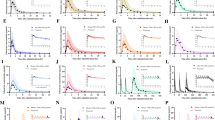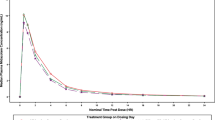Abstract
Objective
The purpose of the study was to study the distribution of poor and extensive metabolizers of CYP2C19 and CYP2D6 and to genotype for CYP2C8 and CYP2C9 among 312 randomly selected Faroese.
Methods and results
The participants were phenotyped for CYP2D6 with the use of sparteine. The distribution of the sparteine metabolic ratio (sparteine/didehydrosparteines) was bimodal, and 14.5% (n=44; 95% CI: 10.7–18.9%) of the subjects were phenotyped as poor metabolizers. The frequency of poor metabolizers was higher (P=0.0002; χ2 test) among the Faroese than in other European populations (7.4%). Genotype analyses for the CYP2D6*3, *4, *6 and *9 alleles were performed using real-time polymerase chain reaction (PCR) (TaqMan, Foster City, CA, USA), and we found 14.6% (n = 45) (95% CI: 10.8–19.0%) with deficient CYP2D6 genes (*3/*4, *4/*4, *4/*6, *6/*6) in the Faroese population. The subjects were phenotyped for CYP2C19 with the use of mephenytoin and 10 subjects, i.e., 3.2% (95% CI: 1.6–5.9%) were phenotyped as poor metabolizers. Genotype analysis for the CYP2C19*2 and *3 alleles was performed by means of PCR analysis, and 2.9% (n=9) (95% CI: 1.3–5.4%) of the Faroese were found to have a deficient CYP2C19 gene all explained by the CYP2C19*2/*2 genotype. The allele frequencies of the CYP2C9*2 and CYP2C9*3 alleles were 8.8% (95% CI: 6.7–11.4%) and 5.3% (95% CI: 3.7–7.4%), respectively, while the CYP2C8*3 allele frequency was 6.9% (95% CI: 5.0–9.2%). Real-time PCR (TaqMan) was used for both CYP2C9 and CYP2C8 genotype analyses.
Conclusion
The frequency of CYP2D6 poor metabolizers is twofold higher among the Faroese population than other Caucasians, while the frequencies of Faroese subjects with decreased CYP2C19, CYP2C8 and CYP2C9 enzyme activity are the same as seen in other Caucasian populations. A possible consequence might be a higher incidence of side effects among Faroese patients taking pharmaceuticals that are CYP2D6 substrates.



Similar content being viewed by others
References
http://www.imm.ki.se/cypalleles
Nebert DW, Russel DW (2002) Clinical importance of cytochromes P450. The Lancet 360:1155–1162
Wedlund PJ (2000) The CYP2C19 Enzyme Polymorphism. Pharmacology 61:174–183
Bertilsson L (1995) Geographical/interracial differences in polymorphic drug oxidation. Clin Pharmacokinet 29:192–209
Alván G, Becthel P, Islius L, Gundert-Remy U (1990) Hydroxylation polymorphisms of debrisoquine and mephenytoin in European population. Eur J Clin Pharmacol 39:533–537
Bertilsson L, Lou Y-Q, Du Y-L, Liu Y, Kuang T-Y, Liao X-M, et al. (1992) Pronounced differences between native Chinese and Swedish populations in the polymorphic hydroxylation of debrisoquin and S-mephenytoin. Clin Pharmacol Ther 51:388–397
Bathum L, Johansson I, Ingelman-Sundberg M, Hørder M, Brøsen K (1998) Ultrarapid metabolism of sparteine:frequency of alleles with duplicated CYP2D6 genes in a Danish population as determined by restriction fragment length polymorphism and long polymerase chain reaction. Pharmacogenetics 8:119–123
Schoch GA, Yano JK, Wester MR, Griffin KJ, Stout CD, Johnson EF (2004) Structure of human microsomal cytochrome P450 2C8. Evidence for a peripheral fatty acid binding site. J Biol Chem 279(10):9497–9503
Dai D, Zeldin DC, Blaisdell JA, Chanas B, Coulter SJ, Ghanayem BI, Goldstein JA (2001) Polymorphism in human CYP2C8 decrease metabolism of the anticancer drug paclitaxel and arachidonic acid. Pharmacogenetics 11:597–607
Tracy TS, Hutzler JM, Haining RL, Rettie AE, Hummel MA, Dickmann LJ (2002) Polymorphic variants (CYP2C9*3 and CYP2C9*5) and the F114L active site mutation of CYP2C9: effect on atypical kinetic metabolism profiles. Drug Metab Dispos 30(4):385–390
Goldstein JA (2001) Clinical relevance of genetic polymorphisms in the human CYP2C subfamily. Br J Clin Pharmacol 52:349–355
Yasar U, Lundgren S, Eliasson E, Bennet A, Wiman B, De Faire U, Rane A (2002) Linkage between the CYP2C8 and CYP2C9 genetic polymorphism. Biochem Biophys Res Commun 299(1):25–28
Debes HJ (1990) Føroya Søga 1. Føroya Skúlabókagrunnur, Tórshavn
Young GVC (1979) From the Vikings to the reformation: a chronicle of the Faroe Islands up to 1538. Shearwater Press, Onchan, Isles of Man
Jorgensen TH, Buttenschon HN, Wang AG, Als TD, Borglum AD, Ewald H (2004) The origin of the isolated population of the Faroe Islands investigated using Y chromosomal markers. Hum Genet 115(1):19–28
Jóhansen J (1885) Studies in the vegetational history of the Faroe and Shetlands Islands. Føroya Fródskaparfelag, Tórshavn
Jeganathan D, Chodhari R, Meeks M, Færoe O, Smyth D, Nielsen K, Amirav I, Luder AS, Bidgaard H, Gqrdiner RM, Chung EMK, Mitchinson HM (2004) Loci for primary ciliary dyskinesia map to chromosome 16p12.1-12.2 and 15q13.1-15.1 in Faroe Islands and Israeli Druze genetics isolates. J Med Genet 41:233–240
Santer R, Kinner M, Steuerwald U, Kjærgaard S, Skovby F, Simonsen H, Shaiu W-L, Chen T-T, Schneppenheim R, Schaub J (2001) Molecular genetic basis and prevalence of glycogen storage disease type IIIA in the Faroe Islands. Eur J Hum Gen 9:388–391
Milman N, Steig T, Koefoed P, Pedersen P, Fenger K, Nielsen FC (2004) Frequency of the hemochromatosis HFE mutations C282Y, H63D, and S65C in blood donors in the Faroe Islands. Ann Hematol 84(3):146–149
Schwartz M, Sorensen N, Brandt NJ, Hogdall E, Holm T (1995) High incidence of cystic fibrosis on the Faroe Islands: a molecular and genealogical study. Hum Genet 95(6):703–706
Hjalgrim H, Tulinius H, Dalberg J, Hardarson S, Frisch M, Melbye M (1998) High incidence of classical Kaposi’s sarcoma in Iceland and the Faroe Islands. Br J Cancer 77(7):1190-1193
Frye RF, Matzke GR, Adedoyin A, Porter JA, Branch RA (1997) Validation of the five-drug “Pittsburgh cocktail” approach for assessment of selective regulation of drug-metabolizing enzymes. Clin Pharmacol Ther 62(4):365–376
Damkier P, Hansen LL, Brosen K (1999) Effect of diclofenac, disulfiram, itraconazole, grapefruit juice and erythromycin on the pharmacokinetics of quinidine. Br J Clin Pharmacol 48(6):829–838
Vinks A, Inaba T, Otton SV, Kalow W (1982) Sparteine metabolism in Canadian Causcasians. Clin Pharmacol Ther 31:23–29
Wedlund PJ, Sweetman BJ, McAllister CB, Branch RA (1984) Wilkinson GR. Direct enantionmeric resolution of mephenytoin and its N-demethylated metabolite in plasma and blood using chiral capillary gas chromatogram. J Chromatogr 13(307):121–127
Sanz EJ, Villén T, Alm C, Bertilsson L (1989) S-mephenytoin hydroxylation phenotypes in a Swedish population determined after coadministration with debrisquine. Clin Pharmacol Ther 45:495–499
Tybring G, Bertilsson L (1992) A methodological investigation on the estimation of the S-mephenytoin hydroxylation phenotype using the urinary S/R ratio. Pharmacogenetics 2:241–243
De Morais SMF, Wilkinson GR, Blaisdell J, Meyer US, Nakamura K, Goldstein JA (1994) The major genetic defect responsible for the polymorphism of S-mephenytoin in humans. J Bio Chem 269:15419–15422
De Morais SMF, Wilkinson GR, Blaisdell J, Meyer US, Nakamura K, Goldstein JA (1994) Identification of a new genetic defect responsible for the polymorphism of S-mephenytoin metabolism in Japanese. Mol Pharmacol 46:594–598
Sandberg M, Johansson I, Christensen M, Rane A, Eliasson E (2004) The impact of CYP2C9 genetics and oral contraceptives on cytochrome P450 2C9 phenotype. Drug Metab Dispos 32(5):484–489
McCann SJ, Pond SM, James KM, Le Couteur DG (1997) The association between polymorphisms in the cytochrome P-450 2D6 gene and Parkinson’s disease: a case-control study and meta-analysis. J Neurol Sci 153(1):50–53
Christensen PM, Gotzsche PC, Brosen K (1998) The sparteine/debrisoquine (CYP2D6) oxidation polymorphism and the risk of Parkinson’s disease: a meta-analysis. Pharmacogenetics 8(6):473–479
Tandberg E, Larsen JP, Nessler EG, Riise T, Aarli JA (1995) The epidemiology of Parkinson’s disease in the county of Rogaland, Norway. Mov Disord 10(5):541–549
Gudmundsson KR (1967) A clinical survey of parkinsonism in Iceland. Acta Neurol Scand 43(Suppl 33):1–61
Wermuth L, Joensen P, Bunger N, Jeune B (1997) High prevalence of Parkinson’s disease in the Faroe Islands. Neurology 49(2):426–432
Eichelbaum M, Gross AS (1990) The genetic polymorphism of debrisoquine/sparteine metabolism–clinical aspects. Pharmacol Ther 46(3):377–394
Bertilsson L, Dahl ML, Dalen P, Al-Shurbaji A (2002) Molecular genetics of CYP2D6: clinical relevance with focus on psychotropic drugs. Br J Clin Pharmacol 53(2):111–122
Meyer UA, Amrein R, Balant LP, Bertilsson L, Eichelbaum M, Guentert TW, Henauer S, Jackson P, Laux G, Mikkelsen H, Peck C, Pollock BG, Priest R, Sjoqvist F, Delini-Stula A (1996) Antidepressants and drug-metabolizing enzymes-expert group report. Acta Psychiatr Scand 93(2):71–79
Stamer UM, Lehnen K, Hothker F, Bayerer B, Wolf S, Hoeft A, Stuber F (2003) Impact of CYP2D6 genotype on postoperative tramadol analgesia. Pain 105(1–2):231–238
Poulsen L, Arendt-Nielsen L, Brosen K, Sindrup SH (1996) The hypoalgesic effect of tramadol in relation to CYP2D6. Clin Pharmacol Ther 60(6):636–644
Acknowledgements
This study was supported by “Apotekerfonden af 1991”, and by grants from the Swedish Science Council, Medicine (00496). The assistance of the employees at the Department of Occupational and Public Health in Tórshavn, Faroe Islands, is highly appreciated. 2,3-Didehydrosparteine and 5,6-didehydrosparteine were kindly donated by Michael Eichelbaum from Dr. Margarete Fischer-Bosch Institute of Clinical Pharmacology in Stuttgart, Germany.
Author information
Authors and Affiliations
Corresponding author
Rights and permissions
About this article
Cite this article
Halling, J., Petersen, M.S., Damkier, P. et al. Polymorphism of CYP2D6, CYP2C19, CYP2C9 and CYP2C8 in the Faroese population. Eur J Clin Pharmacol 61, 491–497 (2005). https://doi.org/10.1007/s00228-005-0938-1
Received:
Accepted:
Published:
Issue Date:
DOI: https://doi.org/10.1007/s00228-005-0938-1




